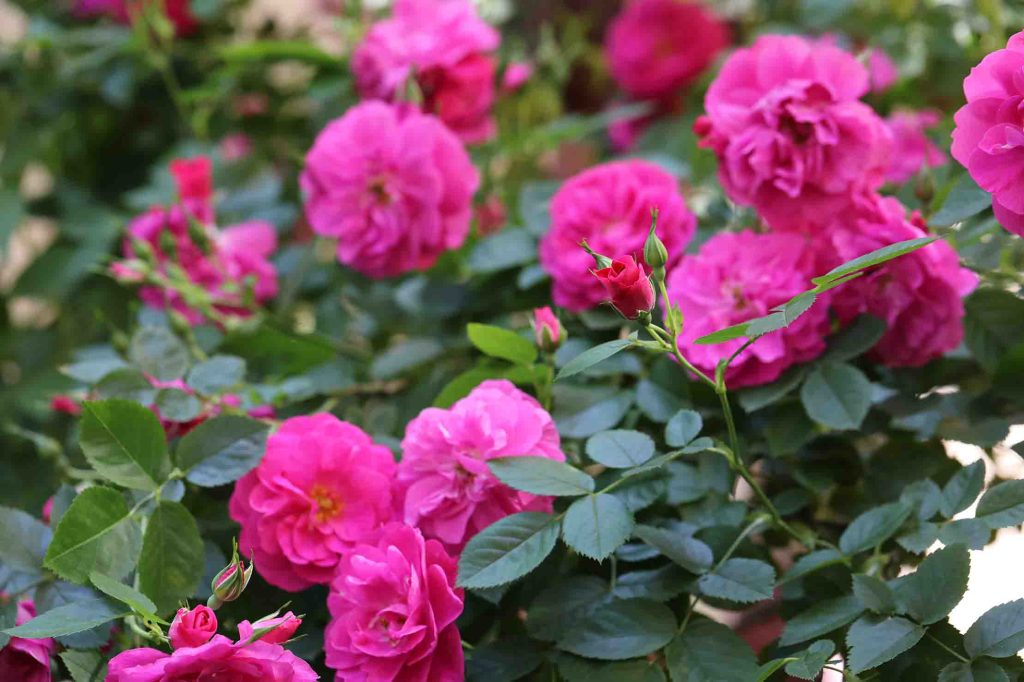“A rose by any other name smells just as sweet” was not written about the John Cabot rose, but it can certainly apply to it. The Rosa kordesii hybrid smells just as sweet as the classic roses we all know and love. Though a hybrid, it stands strong even among the classic rose.
The John Cabot rose is a vigorous, upright shrub that can grow to be 8 feet tall and 5 feet wide. It has dark green, glossy foliage and produces large, full, double flowers that are a deep pink color. It is a climbing flower that can be found growing along garden walls and decorating ceremonial arches, making it a popular flower for outdoor ceremonial sites.
History Of The John Cabot Rose

Developed by Canadian rose breeder Felicitas Svejda in 1969, the John Cabot rose is a hybrid first introduced in Canada in 1978 by Agriculture and Agri-Food Canada. It was the first of the Canadian Explorer roses that Svejda developed and named in honor of legendary Canadian explorers.
Svejda bred the John Cabot rose in 1969, using stock parents, ‘Kordesii’ x (‘Masquerade’ x Rosa laxa). The cultivar is the first Explorer roses series Svejda developed to withstand the harsh Canadian winters and thrive in its short growing season. The rose variety was named in honor of John Cabot (1450–1500), an Italian navigator who first explored the Northwest Passage.
John Cabot rose is a popular bloom that has won numerous awards, including the Award of Garden Merit from the Royal Horticultural Society. It is a beautiful and versatile rose that can be used in a variety of settings including beds, borders, and containers. John Cabot roses are a popular choice for gardens looking to attract butterflies, bees, hummingbirds, and other pollinators.
Characteristics Of John Cabot Roses

John Cabot rose is a hardy climber that produces fragrant double rosy red flowers from early summer to autumn. It is resistant to numerous diseases and is a wonderful selection for trailing over arbors and fences.
Here are some additional details about John Cabot rose:
- Grows to be about 8 feet tall and 5 feet wide.
- Has dark green foliage that turns yellow in the fall.
- Fragrant fuchsia flowers with hot pink overtones.
- Yellow eyes form along the branches from late spring to late summer.
- Produces orange hips in the fall.
- It is a relatively easy rose to care for in comparison to other roses.
- Thorns grow all along the vine.
Growing John Cabot Roses

John Cabot roses are a type of climbing rose that is known for its fragrant flowers and its ability to grow in a variety of climates. They are resilient and relatively easy to care for, making them a good choice for beginner gardeners.
Here are some tips on how to grow John Cabot roses:
- Choose a location that gets full sun. John Cabot roses need at least six hours of sunlight per day in order to bloom their best.
- Plant your roses in well-draining soil. John Cabot roses are not tolerant of wet feet, so make sure the soil you plant them in drains well.
- Fertilize your roses regularly. John Cabot roses need to be fertilized at least once a month during the growing season. Use a balanced fertilizer that is specifically designed for roses.
- Water your roses regularly. John Cabot roses need to be watered deeply and regularly, especially during hot weather.
- Deadhead your roses regularly. Deadheading is the process of removing spent flowers. This will encourage new flowers to bloom.
- Protect your roses from pests and diseases. John Cabot roses are relatively resistant to pests and diseases, but it is still a good idea to inspect your rose regularly for any signs of problems.
With minimal care and maintenance, John Cabot roses will reward you with beautiful flowers for many years to come. Here are some additional tips on caring for these roses after they are planted:
- Prune your rose in the spring. This will help to keep it healthy and encourage new growth.
- Mulch around your rose to help keep the roots cool and moist.
- Cover your rose with a burlap sack or other protective covering in the winter if you live in a cold climate.
Floriography Of Roses

From the moment roses were cultivated, they quickly rose in popularity and stayed at the top ever since. So much so that when the Language of Flowers was formed, roses had meanings attached to colors rather than the flowers themselves.
Dark pink flowers symbolize deep gratitude and appreciation, elegance and grace. This makes them an excellent choice for special occasions. Orange flowers mean fiery emotions, passion and energy, but they can also mean desire and pride.
The orangey hue of the John Cabot rose combined with the dark pink flower on the John Cabot rose made it a popular choice for weddings. These lovely climbing roses draped over a wedding arch are still popular to this day.



